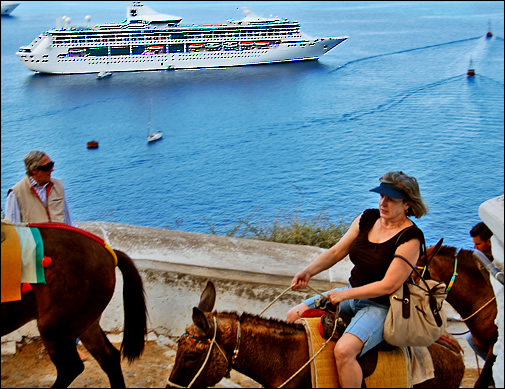Santorini or Thera . . . Corfu or Corcyra — Che?
On the Islands We Find Intimations of Plato and Homer.
By Ron Fritze from the MS Splendour of the Seas
on the Adriatic Sea between Corfu and Venice
Filed on May 20 and posted on June 14, 2010
The Splendour of the Seas arrived at the island of Santorini early on 19 May. It was our first port day with completely pleasant weather. The sun was out and the temperature was just right.
Thera Sat on a Powder Keg.
Santorini is a volcanic island. In ancient times it was known as Thera, but during the Middle Ages it became a colony of Venice and took on the name Santorini or St. Irene. When I say it is a volcanic island, that is an understatement. The eastern Mediterranean region is one of the most seismically active places on the earth. Santorini is located right on top of a fault line where the African tectonic plate is grinding against the Eurasian plate. That creates a lot of earthquakes and some significant volcanic activity.
During the Bronze Age, Thera was home to a city of almost fifteen thousand people. It was also the home of three distinct volcano cones. Thera was a powder keg. Major explosive eruptions occurred in 54,000 BC and 18,400 BC. The latest huge explosion occurred about 1600 BC, although some sources use the date of 1525 BC and others 1450 BC. The older date is based on analysis of ice core samples from the Greenland glaciers and is currently considered to be the most reliable.
When cruise ships arrive at Santorini, they sail into a lagoon that is the caldera (crater) left by the Bronze Age explosion. My visit was punctuated by a crucial mission — not from God, but from Twylia. I was focused.
How to Climb the Towering Cliff?
Ships do not dock at Santorini. Instead, they anchor in the lagoon, where passengers board tenders for the short trip to shore. Once on land, a visitor must choose a method for scaling a nine-hundred-foot cliff, part of the ancient caldera. The prize at the top is the modern town of Fira.
There are three ways to scale the cliff — by cable car, donkey, or foot. The line for the cable car was huge, so I decided to try the donkey ride at a cost of five Euros. Mounting the donkey, I discovered immediately that the handlers just send the donkey on its way and leave the steering to the rider.
Several years ago, they brought the donkeys up and down tethered together in trains. Now it’s an individual thing. Riding on a loose donkey gave me some pause to think. I did get a chance to ask one of the donkey drivers what my donkey’s name was. It was Curley, which made sense given that his mane was somewhat curly. Fortunately, my donkey was a professional. He knew the way to the top. On the way up I noticed that some of the donkeys would slip now and then. Remember, we are climbing up 800 feet on a hairpin path. It was a thrilling ride, but we did not lose anybody that day.
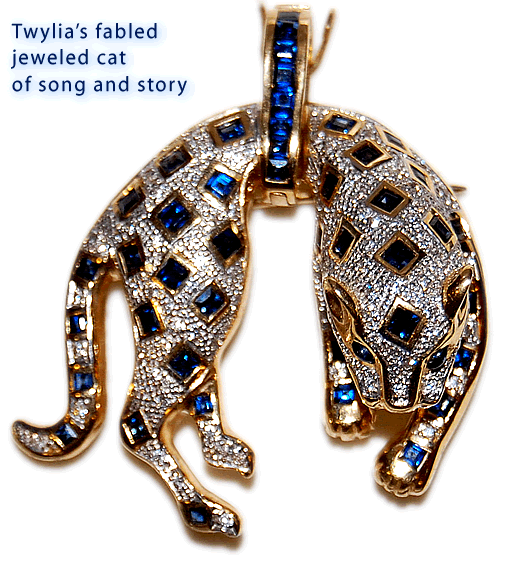 At the top I dismounted and immediately went in search of Yiannis Nicolis, jeweller. My memory was good and I got to Yiannis’s place in less than five minutes. I was on a mission to buy a bejewelled cat for Twylia. Looking in the window, I spotted the cat she had been coveting since our last trip to Santorini. Thomas, who helped us three years ago, was no longer with the store. Instead, I was helped by Yiannis Nicolas himself. We negotiated a good price, deciding to go with sapphires rather than rubies or emeralds as more appropriate to Twylia’s coloring.
So, I had successfully completed my mission from Twylia. Now was the time for me to complete my mission, which was to drink a couple of Mythos beers.
Yiannis had already served one Mythos to lubricate our negotiations. Finding the second was no problem. I stopped at a nice little street cafe and sat down to enjoy my reward. Back on the streets, I engaged in a bit of window shopping, but decided it was time to head back to the ship. I did not like walking around with the sapphire cat.
Surly Help and Road Apples
For the descent, I chose foot. It was steep going, so a little ways down I broke my journey and stopped at another cafe overlooking the lagoon to imbibe another Mythos. They were very proud of their view as the Mythos cost me six Euros. They were also rather surly, which might explain the place being mostly empty. It also saved me a tip, the only time on this trip that I have not left behind a gratuity.
Making my way down the path, there was a certain amount of dodging road apples left by the donkeys. I kept a sharp lookout and avoided stepping in anything nasty, although for some reason a vision of Curley again came to mind. Twylia and I had done this walk three years ago. Today was cooler, so it seemed easier to me than the first descent. There was a tender waiting at seaside. I made it back to the ship in ample time to dress for the formal dinner.
After dining I joined a group of Swedes who had adopted me for their trivia team match beginning at 8:30. It was a tough night and we did not even show. Later at 10:30, I rejoined the Swedes for a British and Irish sing-a-long lead by Lee, the entertainment coordinator. Lee is a wonderful guy with a great personality who also does the evening trivia contests. He looks a bit like that British actor who stars in The Transporter and Deathrace. I was wondering when Lee was going to beat somebody up, but unlike the actor, Lee was always smiling and jolly, a real asset to the ship’s company.
The bay and islands formed by volcanic eruptions
are shown in this map of Santorini
Doomsday Arrives at Thera.
What about ancient Thera? Its idyll as a prosperous Bronze Age port, now called Akrotiri by archaeologists, came to an end about 1600 BC as the pressures of the seismic forces beneath it reached a dangerous level. Unlike some volcanoes on the verge of a major eruption, Thera’s gave its inhabitants plenty of warnings that doomsday was at hand. A series of earthquakes struck the island with increasing severity, causing the Theran population to flee in terror.
It was a good thing, too, because the last quake was quite strong and destroyed many houses. The volcanoes also ejected a large amount of pumice that rained down on Akrotiri and filled its streets knee-deep with ash. Eventually the earth became calm again, prompting some of Thera’s residents to return to their homes to clean up and repair the damage. It took about a year to restore the island back to normalcy.
This respite from the fury of the volcanoes lasted between two and five years. Eventually the earthquakes resumed with stronger and stronger tremors. Once again many of the Therans abandoned their homes. Then the volcanoes began to spew steam, gas, and sulfurous smoke onto the island. As the earth continued to rumble, the few remaining workers threw down their tools and fled to the last ships in the harbor to make their escape on the sea.
Behind them the eruption continued. Three volcanic cones disappeared and a gaping, widening crater began to appear in their place. Fine white pumice mixed with the steam escaping from the maw of the volcano and fell upon the island, covering it with a layer two centimeters thick. Then for a second time, the eruption halted, but not for long. The next phase of brought a rain of pumice that eventually covered the island with a layer over a meter deep. Debris from the widening crater, blown into the air by the pressures from within the volcano, plummeted down on the island. In the skies a cloud of smoke and steam rose over Thera to the altitude of thirty-five kilometers.
The longer the eruption continued, the more the volcano’s crater grew until seawater began to leak into the crater, causing the ejection of vast quantities of wet ash. Eventually, the magma chamber beneath Thera emptied itself. At that point gravity caused the rim of the volcano to collapse back into its magma chamber, and soon the super-hot magma chamber was flooded with seawater. Explosions caused by the collapse of the magma chamber would have been heard as far away as Egypt, Pakistan, and southwestern England.
The Devastation Was Epic.
As a result of the collapse, a substantial section of pre-eruption Thera disappeared. In its place a bay had been formed, extending as deep as five hundred meters into the warm sea and surrounded by a rim of cliffs formed by the caldera.
The immense displacement of solid materials and water through implosion and explosion combined with the earthquakes to give rise to fierce tsunamis. These fanned out from devastated Thera and crashed into the coastline of Crete within a half hour of the last great explosion. Crete and other neighboring Aegean islands suffered extensive damage. The eruption also created a massive ash cloud, which drifted on the southeasterly winds to fall on eastern Crete and the coast of southwest Asia Minor, blighting the vegetation.
The tsunamis and ash clouds terrorized Egypt and caused significant damage, leading some writers to suggest that Thera’s eruption might have been responsible for some of the biblical Ten Plagues of Egypt and the parting of the Red Sea with the accompanying destruction of Pharaoh’s army.
Thera’s ancient eruption was four times more powerful than the legendary explosion of Krakatoa in 1883. The less well-known but far more intense eruption of Tambora in Indonesia in 1815 was approximately the same size as Thera’s. They stand in history as the two most violent volcanic eruptions during the past four thousand years.
The great Bronze Age eruption did not end volcanic activity on Thera, nor did it end human occupation. People, animals, and plants returned to the island. Eruptions also continued, but none approached the size of the Bronze Age event.
The rim of the caldera rises above the Santorini bay,
formed by the ancient eruption ~ May 19, 2010
Eruption after Devastating Eruption
Continually Alters the Landscape.
After a quiet interval of over a thousand years, the next recorded eruption occurred in 197 BC, giving rise to the new island of Heira. The island’s creation signified that a new magma chamber was forming in the lagoon. Another eruption took place in 46 AD, followed by an interval of seismic quietness lasting almost 700 years. The next eruption spread pumice around the Aegean and formed another island in the lagoon. This island later merged with Heira to form the island of Palea Kameni (old burned island).
Other eruptions occurred in 1457 and during 1570-1573 when another island appeared in the lagoon called Mikra Kameni (small burned island). During 1650 a series of earthquakes culminated in an eruption several miles to the northeast of Thera, during which an island briefly appeared and then disappeared beneath the sea. It produced much pumice. Another series of eruptions occurred during 1707-1711 which resulted in the formation of Nea Kameni (new burned island). In 1866-1870 a renewed series of eruptions caused Nea Kameni and Mikra Kameni to merge as one island.
Twentieth century eruptions occurred in 1925-28, 1939-41, and 1950. All brought forth lava flows that gradually increased the size of Nea Kameni, presenting an interesting scenario. If Nea Kameni continues to grow, it will eventually form a lava dome comparable in size to the Bronze Age island. Nea Kameni will likewise possess the potential for another enormous explosion, although vulcanologists predict that likelihood stands a few thousand years in the future.
A more real and present danger to Santorini is the underwater volcano of Columbo located about a mile off the northeast coast of the island. Yiannis Nicolis told me that it is apparently oozing lava underwater and has a great explosive potential as the vent out of its magma chamber is very long and narrow. Such an explosion would devastate Santorini to a degree worse than any previous eruption since the great Bronze Age eruption. The one bit of good news in this is that geologists believe that local people will have about three months of warning signs of an impending explosion.
Thera Joins Troy and Sipylus
As Possible Locations for Atlantis.
A dramatic and traumatic event like the eruption of Thera would have seared itself into the folk memory of the people of the Aegean and the eastern Mediterranean. In fact, for the past one
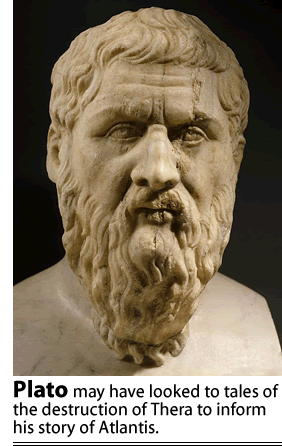 hundred years reputable historians and archaeologists have been suggesting that tales of the destruction of Thera provided Plato with the inspiration for his account of Atlantis. This approach to Plato’s story historicizes Atlantis, and while Thera remains the most favored location for the fabled ancient civilization, other thinkers have suggested Troy or the city of Sipylus near Smyrna in Asia Minor among other alternative historical foundations for Plato.
hundred years reputable historians and archaeologists have been suggesting that tales of the destruction of Thera provided Plato with the inspiration for his account of Atlantis. This approach to Plato’s story historicizes Atlantis, and while Thera remains the most favored location for the fabled ancient civilization, other thinkers have suggested Troy or the city of Sipylus near Smyrna in Asia Minor among other alternative historical foundations for Plato.
The trouble with this situation is that multiple historicized Atlantises, each competing for acceptance, leave a bewildered public asking, “Will the real Atlantis please stand up?” For us the question is, how did Santorini come to be identified with Atlantis?
The fact that Thera was an important Bronze Age trading center was unknown to historians between the time of Classical Greece and the mid-nineteenth century. Based on knowledge available at that time, Thera and the Minoans of Crete were civilizations lost to human memory.
Then, in the 1860s French archaeologists discovered significant ruins on Santorini, prompting the scholar Louis Figuier to suggest for the first time that Santorini’s ruins could be connected to Atlantis. No one paid much attention to Figuier’s suggestion until the early years of the twentieth century when Sir Arthur Evans discovered the palace of Knossos on Crete, which opened fresh speculation about the forgotten Minoan culture.
Intrigued by Sir Arthur’s discoveries, the English classicist William Frost wrote an anonymous article for the London Times in 1909 suggesting that the Minoan civilization of Crete was destroyed by the Thera eruption and served as the historical inspiration for Plato’s Atlantis story. Ever since that time, the Thera-Crete as Atlantis theory has been popular among many classical archaeologists. The Greek archaeologist Spyridon Marinatos took up the theory and conducted excavations on Santorini that led to the discovery of the important and well-preserved site at Akrotiri.
History or Science Fiction?
Other variations on the theme of a Santorini-Atlantis connection continue to appear. Naturally, scholars come forth to dispute the theory and its variations. Some suggest other locations for Atlantis. Others simply reject the idea that Plato took the inspiration for Atlantis from any particular historical event, postulating that the Atlantis story is simply the first known science fiction story.
Me? I side with the science fiction camp. I base my opinion on the preponderance of evidence as well as the personal conviction that the simplest explanation is generally the best explanation. Meanwhile I look forward to visiting Santorini when the archaeological site at Akrotiri is finally reopened after years of being closed.
From the comfort of my bed on a ship at sea, my speculations about the origins of Atlantis eventually led to sleep and dreams. I awoke with thoughts about our impending arrival at Corfu.
My lecture on the history of Corfu began at 11 a.m., two hours before our scheduled arrival. Over forty people showed up — an appreciative audience, I thought, with lots good questions at the end. I skipped lunch so I could be sure to catch the bus into the town of Corfu.
No Icon, Just Beer and a Dog.
Once again, the weather let us down. Walking from the ship to the cruise terminal, I felt the raindrops begin to fall. Then it rained harder. I finally got on a bus. Fortunately no one took my ticket. The driver took us down to the drop off point in town. By the time we got there, it was beginning to look like a hurricane was coming ashore. I decided to stay on the bus.
Back at the terminal, I checked out the duty free store. Nothing inside caught my fancy, but outside the sun had begun to shine. Ticket still in hand, I counted my blessings and boarded another shuttle destined for downtown Corfu. There I saw the old Venetian fortress close up, walked through a park, and explored the downtown.
I was looking for an icon of Christos Pantokrator but didn’t see one I liked. I did find a promising, out-of-the-way place to try some
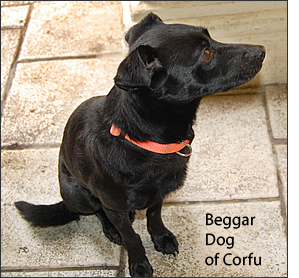 Greek food. The cafe was called Pitanostimies — in Greek, it’s
Greek food. The cafe was called Pitanostimies — in Greek, it’s  — and yes, they serve pitas. I enjoyed a Greek sausage pita and a Mythos beer, both quite good. A little black dog was begging outside the restaurant. From my seat on the porch I was able to do a little sharing with him. Pitanostimies did a good business, better then the upscale places on the main street. It’s always a good idea to venture a street or two beyond the main thoroughfare for food and shopping. Prices drop and the food is often better. Look for where the locals are eating. — and yes, they serve pitas. I enjoyed a Greek sausage pita and a Mythos beer, both quite good. A little black dog was begging outside the restaurant. From my seat on the porch I was able to do a little sharing with him. Pitanostimies did a good business, better then the upscale places on the main street. It’s always a good idea to venture a street or two beyond the main thoroughfare for food and shopping. Prices drop and the food is often better. Look for where the locals are eating.
Back at the terminal again, I ran into some of my Swedish trivia teammates. They had gone on a mountain village excursion that turned into a Survivor episode, encountering fierce torrential rains, roaring thunder, and hail the size of jawbreakers, enough to cover the ground in white. They said it was freezing and being from Sweden, they know freezing.
A Place to Fight Wars Over.
Corfu is the oldest of the Greek resort islands. Despite years of being a warm weather destination for tourists, the island has a lot of historical interest. My hope is that one day I can explore it to the fullest with Twylia — and on day with pleasant weather.
Corfu is under the red A icon to the east
Historically, Corfu was one of those places that people fight wars over. Its importance lay in its strategic location at the meeting place of the Ionian Sea and the Adriatic, where it served as a convenient stepping stone for ancient sailings between Greece and Italy. In times of war Corfu became a prime staging area for attacks on Italy or Greece.
Corfu is also known as Kerkyra or Corcyra. The island is forty miles long (64 km) and varies in width from 7 to 17 miles (11 to 27 km). Olives, figs, oranges, lemons, and grapes are grown on its fertile farmlands.
Corfu was not always an island. Some 50,000 years ago, when the sea level was much lower, lands now covered by the Adriatic were great forests, including present-day Corfu, which was connected to the mainland. The first archaeological evidence for human habitation can be dated to this time.
A Helping Hand for Odysseus?
Some people, both ancient and modern, have suggested that Corfu is the model for the Scheria in Homer’s Odyssey. Homer describes Scheria as a fertile land with a mild and pleasant climate where fruit can be grown all year. There was a wonderful harbor on
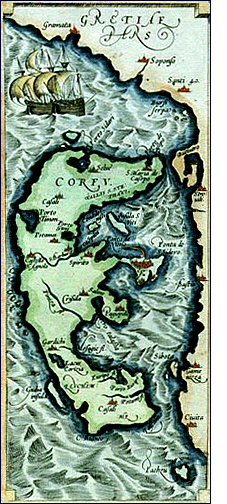 Scheria that was protected because it was almost entirely enclosed by land. It was the home of the Phaeacians, a mysterious but friendly people who were great seafarers and possessed magic ships capable of sailing great distances overnight. Their king was named Alcinous and it was his daughter Nausciaa who first aided the shipwrecked Odysseus when he washed up on the shore of Scheria.
Scheria that was protected because it was almost entirely enclosed by land. It was the home of the Phaeacians, a mysterious but friendly people who were great seafarers and possessed magic ships capable of sailing great distances overnight. Their king was named Alcinous and it was his daughter Nausciaa who first aided the shipwrecked Odysseus when he washed up on the shore of Scheria.
Alcinous was known for helping troubled seafarers. Earlier he had provided hospitality to Jason, Medea, and the Argonauts. It was while he was a guest of Alcinous that Odysseus told the tale of his wanderings after the fall of Troy, including the encounter with Polyphemus the Cyclopes and his journey to the Underworld. An impressed Alcinous offered Odysseus the opportunity to marry Nausciaa, but Odysseus declined as he was anxious to return to his wife Penelope and bring an end to their twenty-year separation.
Not one to hold a grudge, Alcinous ordered a Phaeacian ship take Odysseus back to Ithaca where they dropped him off. This action enraged the sea-god Poseidon, who hated Odysseus. He turned the Phaeacian ship into stone and used it to block up the harbor of Scheria.
The idea that Corfu was the location of Scheria faltered due to its proximity to Ithaca, which was only 80 miles to the south. That reality contradicts Homer’s account of the magic Phaeacian ship miraculously sailing a great distance overnight to bring Odysseus back to Ithaca.
Corinth Named It Corcyra.
Corfu moved from the realm of myth and legend into history when the mainland Greek city of Corinth established a colony named Corcyra on the island in about 734 BC. In doing so, the Corinthians expelled an earlier colony established by the city of Eretria on Euboea Island. The derivation of the name Corcyra is uncertain. It is possibly a native Illyrian word, or it might be related to the word “gorgon,” which held close associations to Corinth through its mythical hero Bellerophon.
Corcyra grew into a powerful city in its own right thanks to its rich soils and favorable location on the sea route between Greece and Italy. It is important to remember that the Greeks heavily colonized the southern half of mainland Italy, which was known as Magna Graecia. They also colonized the western two-thirds of the island of Sicily.
Growing in power and wealth, Corcyra eventually broke free of Corinthian domination. Relations between the mother city and its former colony were sometimes poor — so poor, in fact, that conflict between Corcyra and Corinth helped to spark the great Peloponnesian War between the rival alliances of Athens and Sparta. The rise of factions of Corcyrans supporting either Athens or Sparta lead to a civil war of brutal reprisals and savage violence in which normal human decency was forgotten. As the ancient historian Thucydides described it:
“As a result of these revolutions, there was a general deterioration of character throughout the Greek world. The simple way of looking at things, which is so much the mark of a noble nature, was regarded as ridiculous quality and soon ceased to exist. . . . As for ending this state of affairs, no guarantee could be given that would be trusted, no oath sworn that people would fear to break; everyone had come to the conclusion that it was hopeless to expect a permanent settlement and so, instead of being able to feel confident in others, they devoted their energies to providing against being injured themselves. As a rule those who were least remarkable for intelligence showed the greater powers of survival.”
Everyone Wanted a Piece of It.
Athens was ultimately defeated by Sparta but still managed to make a comeback. Part of that comeback included a renewed alliance with Corcyra in 375 BC. Their continuing alliance is not at all surprising given their common trading interests and animosity with Corinth and the Peloponnesian League.
The coming of Alexander the Great resulted in Corcyra becoming a pawn in great power struggles. First the Macedonians, then the Syracusans, the Illyrians, and then the Romans took control of Corcyra. Its strategic location was too important to be ignored.
During the Roman Civil Wars, the Corcyrans picked sides poorly. They supported Pompey against Caesar and Mark Anthony against Octavian. During the early Middle Ages it belonged to the Byzantine Empire until it became a possession of the Venetian Empire in 1386. At that point it name changed to Corfu. It remained a Venetian possession until the dissolution of the Venetian republic in 1797.
The British occupied the island from 1815 until1864 when it became part of the modern country of Greece where it remains today.
Tomorrow is a sea day and then we arrive back in Venice. Weather permitting, I plan on visiting the Doge’s Palace and anything else I can cram into a single day.

Click on the black panther to read the previous installment of Ron's 2010 cruise dispatches,
From the Adriatic to the Aegean, We Arrive at Ancient Ephesus.. |



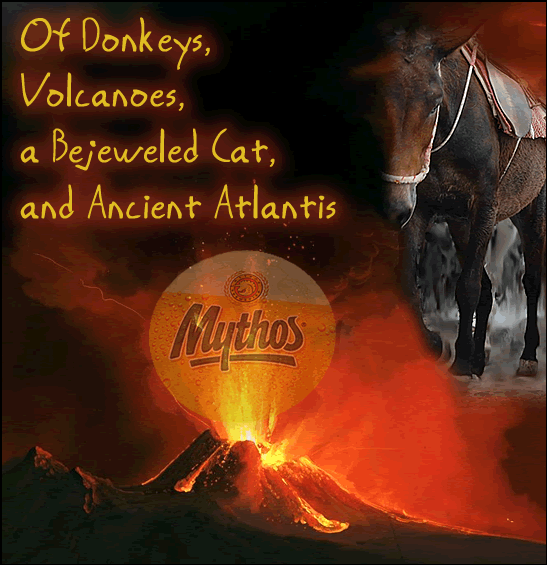


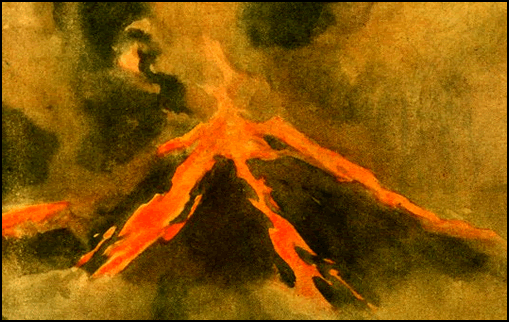
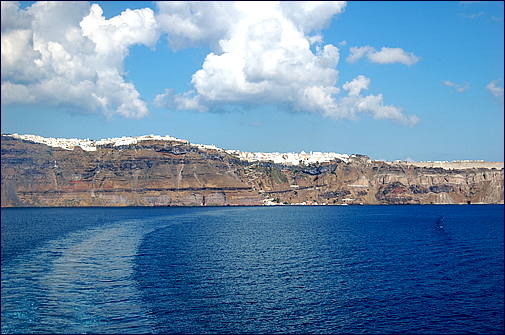
 hundred years reputable historians and archaeologists have been suggesting that tales of the destruction of Thera provided Plato with the inspiration for his account of Atlantis. This approach to Plato’s story historicizes Atlantis, and while Thera remains the most favored location for the fabled ancient civilization, other thinkers have suggested Troy or the city of Sipylus near Smyrna in Asia Minor among other alternative historical foundations for Plato.
hundred years reputable historians and archaeologists have been suggesting that tales of the destruction of Thera provided Plato with the inspiration for his account of Atlantis. This approach to Plato’s story historicizes Atlantis, and while Thera remains the most favored location for the fabled ancient civilization, other thinkers have suggested Troy or the city of Sipylus near Smyrna in Asia Minor among other alternative historical foundations for Plato. Greek food. The cafe was called Pitanostimies — in Greek, it’s
Greek food. The cafe was called Pitanostimies — in Greek, it’s 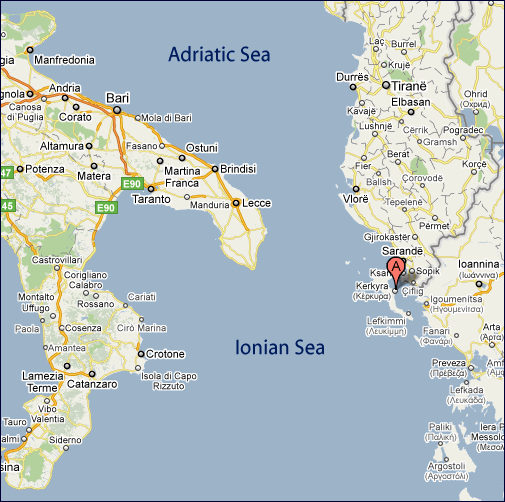
 Scheria that was protected because it was almost entirely enclosed by land. It was the home of the Phaeacians, a mysterious but friendly people who were great seafarers and possessed magic ships capable of sailing great distances overnight. Their king was named Alcinous and it was his daughter Nausciaa who first aided the shipwrecked Odysseus when he washed up on the shore of Scheria.
Scheria that was protected because it was almost entirely enclosed by land. It was the home of the Phaeacians, a mysterious but friendly people who were great seafarers and possessed magic ships capable of sailing great distances overnight. Their king was named Alcinous and it was his daughter Nausciaa who first aided the shipwrecked Odysseus when he washed up on the shore of Scheria.